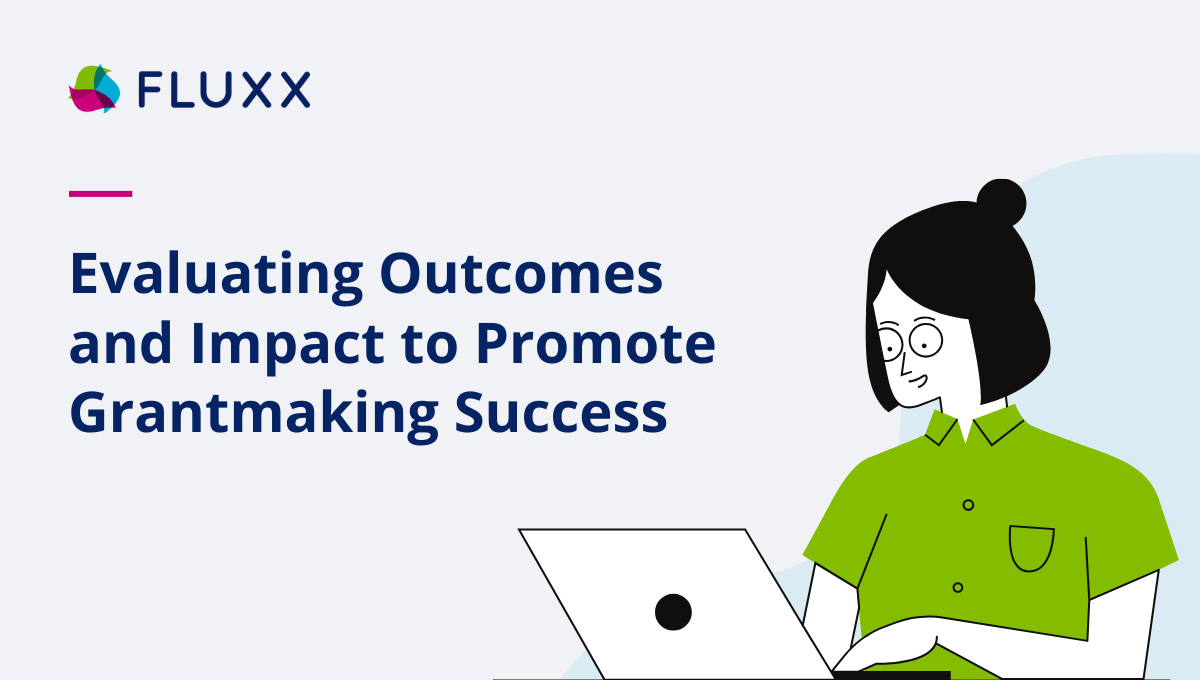
In charitable giving, terms like impact, outcomes, and return on investment (ROI) get thrown around a lot — with good reason. These measurements illustrate grantee performance and indicate whether grantees will achieve their stated goals and drive the change they seek. The value of measuring outcomes and impacts cannot be overstated. The nonprofit industry accounts for 5.6% of the U.S. GDP, contributing more than $2 trillion to the national economy annually. Thoughtful program evaluation can help grantmakers forecast the ROI of their giving and guide them toward investments with the most profound impacts. Over time, strategic evaluation improves the effectiveness of their grantmaking.
Despite our unprecedented access to data and systems for data analysis, grantmakers and funders still struggle to determine if their investments are achieving the results they intend. Effective evaluation doesn’t happen by chance but through solid measurement strategy, focused data collection, and understanding of the time required to achieve sustainable change. Successful grantmaking — that achieves its intended impact — requires strategic data collection, beginning with collecting meaningful data. Clarifying what information the data should provide, and how that data will be used, saves time and money — both precious grantee resources. Collecting the right data gives grantmakers and their grantees insight into where their resources can be best directed to advance their missions.
Measurement Strategies
When creating a measurement strategy, there is also a question of whether impacts are immediate and tangible or longer term and subject to shifting parameters. For capital investment, an effective measurement strategy would be to compare what might have happened differently if the specific output had never existed. For complex projects with dynamic, moving targets, strategic benchmarks measured against the organization’s theory of change can provide a meaningful basis for evaluation. Developing data and evaluation strategies directly linked to theories of change is an effective means of demonstrating progress toward the mission. The bottom line is that good evaluation strategies confer significant advantages to grantmakers and their stakeholders, ensuring progress.
Looking Beyond Financial Indicators
Though it is tempting to rely solely on financial indicators, there are many instances where thinking holistically about an organization’s impact means looking beyond basic financials such as overhead expenditures. One of the first steps in creating effective evaluation methods is understanding, as grantmakers, that different types of nonprofit organizations have different types of cost structures. Overhead ratios vary wildly depending on the services an organization offers. Some could achieve deeper impacts if they spent more on overhead than they allow themselves to spend due to concerns about funder scrutiny.
Other factors worth considering are governance, leadership, results, and transparency. Specific questions can help evaluate outcomes and impacts. Is the work evidence-based and consistent with the organization’s logic model? If the work serves a specific demographic, does the organizational leadership include representation from that community? Is the organization well managed and aspiring to reasonable annual goals? Finally, does the organization collect feedback from constituents, especially on a long-term basis? Gathering input from external stakeholders familiar with a nonprofit’s work, such as other funders or community leaders, can give valuable insight into impacts and outcomes. Paying for performance requires a comprehensive evaluation of an organization’s work, leadership, and results.
Leveraging Evaluations to Maximize Impacts
Determining how a grantmaker will collect data is critical. Without the capacity and expertise to internally analyze data, demanding large amounts of evaluation data becomes a burden both on the funder and the grantee. Many organizations lack the internal resources or training needed to use their data to demonstrate impact effectively. If an organization lacks the budget or staff for data measurement and evaluation, offering support as a funder sometimes makes sense. Working with external resources to evaluate data is a solution that can serve both parties, but collecting focused and meaningful data will simplify the process considerably. For more holistic evaluations, reviewing annual reports and conducting interviews with leadership can provide deep insights — provided a relationship of trust is established. When honest feedback reveals gaps in an organization’s budget, the best response may be to give in areas where funding will yield the most significant results, even if it means unrestricted giving toward overhead costs.
Effective Evaluation Supports Organizational Improvement
Evaluation is a two-way street. Grantees need to demonstrate they are achieving the impacts and outcomes they seek, just as grantmakers must prove they are advancing their missions and making change. But there is more to measuring and evaluating results than simply tracking grants made and analyzing grantee data to determine impact. Gathering data can help institutions and organizations learn how to make their work more effective. A good evaluation strategy helps organizations collect data that will guide more effective program delivery, including making changes to improve impacts.
By supporting organizations in gathering data that makes understanding impacts easier, funders can use the evaluation process to build healthier relationships with recipients. Establishing deeper, more trusting funder/recipient relationships gives funders the ability to support grantees in ways that help them leverage their resources to do more good. Last but certainly not least, recognizing that the problems organizations are trying to address and the ecosystems around them are both subject to change often means that investments must be ongoing. The most impactful funders support efforts that combine effectiveness and scalability in equal measure. Effecting sustained change sometimes means helping design and fund solutions that will work at scale over long periods of time. If evaluation is the key to determining who is doing the work that will best advance a grantmaker’s mission, then leveraging tools to simplify that process is in the best interest of all parties involved. Request a demo to explore just such a purpose-built tool for grantmakers, designed by Fluxx to use data to increase impact.